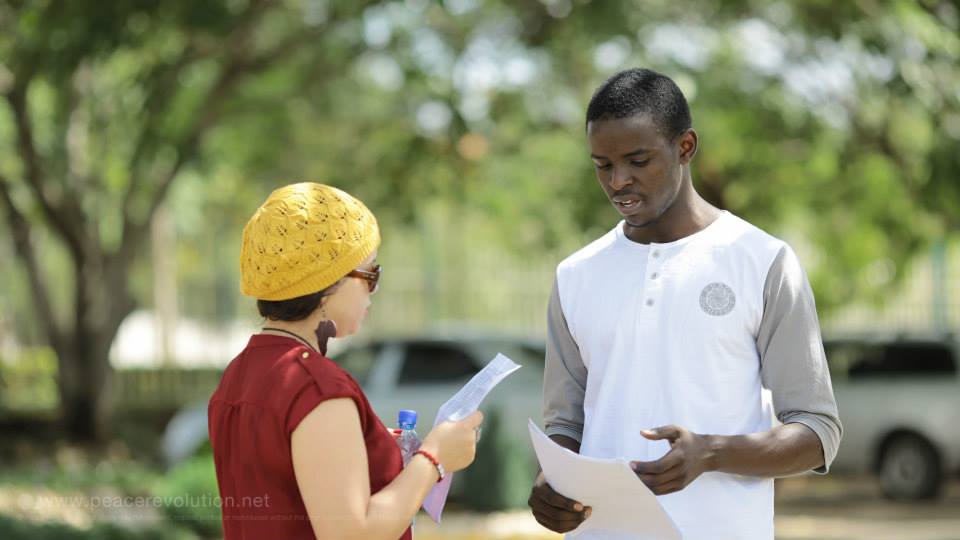World military expenditure in 2012 was estimated to $1756 billion, representing 2.5 per cent of global gross domestic product (GDP) or $249 for each person in the world, according to the Stockholm International Peace Research Institute. By end-2013, 51.2 million individuals were forcibly displaced worldwide as a result of persecution, conflict, generalised violence, or human rights violations, shows the 2013 War’s Human Cost report by the UN Refugee Agency (UNHCR).
Making peace with guns is not working. We know it. Intervening and playing the hero card in conflict prone areas is not working. And we know it. Taking care of victims and patching up lives is not working. And we know that too. Ok, we are not very good at peacekeeping, but what’s the solution, you will ask?
Zoom out. What if we make it about the individual, about the “me”? What if in this way of acting we find our answers? Ask yourself: what could I do to prevent a conflict from erupting? Build world peace is a noble life goal which becomes more and more tangible when we take small, but steady steps. So, let’s start at the micro-organism level: ourselves, our family, our friends, our team members.
Try to think of a conflict you were recently a part of. Can you recognise these steps? Does this conflict model apply?

Image Credit: Peace Revolution
1. First comes the trigger: my flatmate John drank the orange juice to the last drop and left the empty carton in the fridge. Again.
2. Second step is bringing up more issues. Since I am already quite angry with him, I realise how much I dislike the sound of his alarm at 5 AM even on Sundays. Plus, he never takes the dog out. It is always poor little me. Not to mention his drum kit! It takes too much space in our little living room.
3. Third level is creating alliances. I become more friendly than usual towards our third flatmate, Zoé. One evening I cook dinner for the two of us. This is where I set up the context of complaining about John and his ways. Of course, I make it very clear to her that between the two of us we could find a solution. If only she could also tell him how annoying he is when he does this and that…
4. The next stage, distortion of the communication, begins. One morning, John arrives in the kitchen. When I invite him to have breakfast, he excuses himself saying “I’d love to. Could we, maybe, do it later, I’d like to go for a run first?” What I understand is “He just refused to have breakfast. Clearly, he’s mad at me and does not want to be in the kitchen at the same time.” Later on when I see Zoé I let her know: “John was very impolite this morning. He refused to have breakfast even if I personally invited him.”
5. Now, we have reached the point where me and John can no longer be in the same room. It’s the extreme positions stage. Whenever he comes into the kitchen, I ignore him and go into my room.
6. The last level is focusing on hurting the other. Since I know John cares a lot about his big Christmas mug, I begin to be careless when I use it. I don’t make any effort when I see the cat playing with it and breaks it. I use every opportunity to pinpoint his flaws. From here on, our friendship is set to decline.
Now, what can we do to prevent conflicts from escalating? There is a way of avoiding the conflict to break out at every step of this model, would you agree? So, what I regularly do is ask myself this question: “Who do I need to be in the present moment to smooth out this conflict?”
Also, when I am in a tense situation, I usually say these three affirmations:
- “I am human. The person I have in front of me is also human. I have feelings and emotions. So, do you. I accept myself fully. I accept you fully”
- “I am fully present. I am now listening to you.”
- “I acknowledge and accept your opinions and emotions.”
What about actions that we could take?
- Practice mindfulness in all aspects of your life. Be present and observe your thoughts, feelings and emotions. Make the decision that would best benefit you and your partner at the moment of the discussion.
- Meditate. Meditation is a way of being connected to yourself, not only during the 30 minutes of sitting down and stilling your mind down, but also throughout the day. Stay in kind and authentic connection with who you truly are.
- Be curious. Ask more questions. You will find out the true motives, needs and concerns behind your interlocutor’s actions.
- Be patient. Actively listen. Give yourself time to understand the perspective of the person you have in from of you.
- Act instead of react. Take a moment to make a decision before rushing into affirming or doing anything.
- Respect the other’s point of view. Perceive it as equally valid and important as yours.
- Make sure to be calm and willing when you are having a discussion. If you are still governed by anger, better wait to calm yourself.
Certainly, you won’t see the outcomes on a global level tomorrow. Still, imagine what would become possible if each of us started with ourselves. How would we evolve as communities? How many resources and human lives would be spared?
Start small, humble and ask yourself this question now: who do I need to be so as to be at peace with myself and with those around me?


